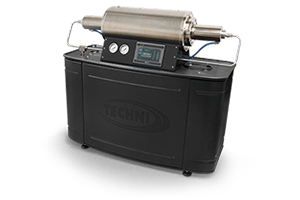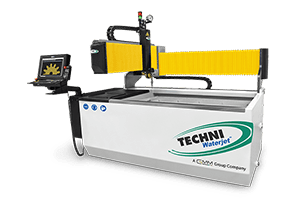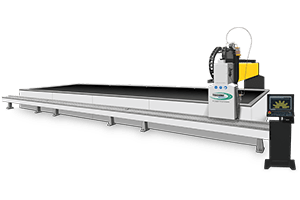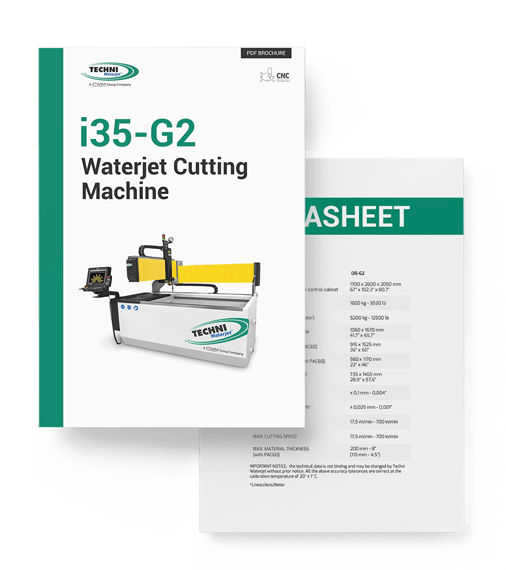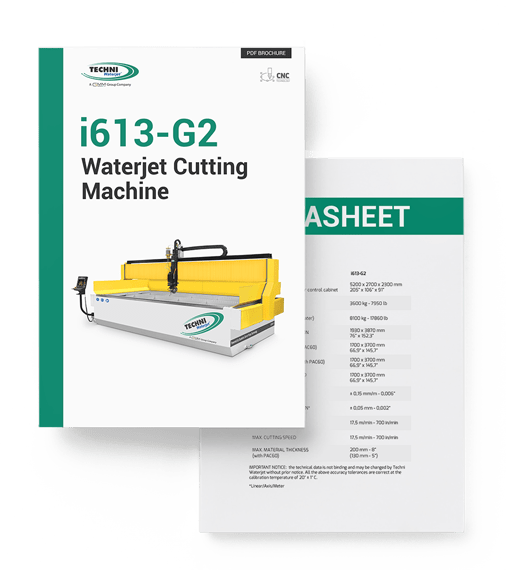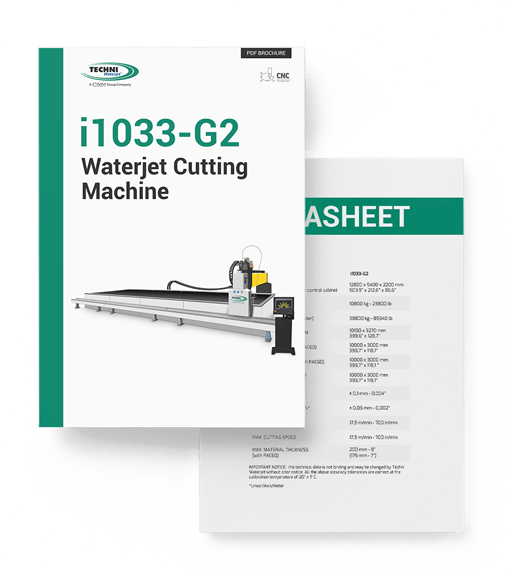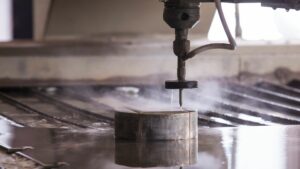Cutting rubber sheets in industries is quite challenging due to the physical properties of rubber and the high quantity and thickness of rubber sheets in industrial settings. The challenges in rubber cutting and the drawbacks of blade cutters led manufacturers to search for an alternative rubber-cutting process.
Waterjet cutting is one of the best cutting alternatives to conventional cutting processes, finding involvement in rubber cutting for more than half a century now. In fact, this is the technology of choice for all rubber processing companies, from small-scale manufacturers to large-scale plants.
In this article, we will discuss the water jet cutting process for rubber, its benefits, applications, and other useful information.
Can You Cut Rubber With a Water Jet Cutter?
Yes, it is possible (and very easy) to cut rubber with a water jet cutter. In fact, the capabilities of the waterjet cutter of rubber outdo any other method like die cutting, whether in terms of rubber sheet thickness or cutting accuracy. Additionally, waterjet cutting is not limited to pure rubber but also applies to rubber-backed metals, among dozens of other materials.
Some of the common rubbers that you can cut with a water jet cutter are:
- Natural rubber (NR)
- AFLAS rubber (TFE/P)
- SCE-42 Sponge
- Pressure Sensitive Adhesive (PSA)
- Butyl rubber (IIR)
- Polyurethane (AU)
- Chloroprene rubber (Neoprene)
- Ethylene Propylene Diene Monomer (EPDM)
- EPDM rubber
- Cloth-inserted rubber
- Fabric reinforced rubber
- Epichlorohydrin rubber (ECO)
- Fluoroelastomers (fluorocarbon-based synthetic rubbers)
- Fluorosilicone rubber
- Hydrogenated nitrile rubber (HNBR)
- Styrene-butadiene rubber (SBR)
- Vulcanized rubber
- Chlorosulphonated polyethylene (CSM)
- Kalrez rubber
- Polyacrylic rubber (ACM)
- Rubber backed Metals
- FDA-certified rubber material
What are the Benefits of Using a Water Jet to Cut Rubber?
There are many advantages that waterjet cutting provides over other cutting technologies. Some of these advantages are:
No Heat Affected Zone
Cutting rubber through any other cutting technologies such as laser cutting process or blade cutting leads to the creation of a heat-affected zone (HAZ). HAZ leads to the melting of rubber in the area and can spoil the entire sheet. However, waterjet cutting is a cold cutting process so there are no heat-affected zones and no melting.
No Toxic Fumes
When rubber is subjected to high temperatures, it releases toxic fumes that are unhealthy for the human workforce. However, since waterjet cutting does not lead to any temperature rise in the raw material, there is no emission of toxic fumes.
Cutting Thicker Materials and Stacking
With waterjet cutting, there is no maximum limit to the thickness of rubber sheets that you can cut. In fact, to multiply the production rate, you can stack multiple sheets of rubber materials on top of each other (up to 8 inches) and cut them simultaneously with waterjet cutting. This process is called stacking. It will significantly save production time for manufacturers.
Environment Friendly
Water jet cutting of soft materials like rubber does not require any abrasive. The water used in the process can be strained and recycled back into the system. This makes the water jet cutting process a very environment-friendly technology. Not to forget, there are no heating effects and no toxic fumes too.
Cost-Effective and Efficient
Waterjet cutting is a cost-saving method due to a number of involved factors. Firstly, the cutting tool is water itself which is cheap and recycled into the system. Secondly, the waterjet cutting process is automated so no human workforce is required. Thirdly, by using stacking you can produce parts up to ten times faster, leading to higher production.
High Precision
Even with the low operating cost and faster production, waterjet cutting does not compromise on precision and accuracy. Waterjet cutting has one of the lowest tolerances among any cutting process, leading to very high accuracy. Furthermore, it allows the manufacturing of even the most intricate designs.
Versatile Shapes
Waterjet cutting has no limitations when it comes to cutting shapes. If a shape is imaginable, it is possible to cut it using a water jet cutting machine. High-quality waterjet cutting equipment like the Techni Waterjet cutters come with software that has common cut shapes preloaded. To make any shape, the operator only has to select the option in the software. Even small parts like rubber gaskets can be made with ease using a water jet.
Minimal Material Wastage
Waterjet cutting has a very low kerf and removes minimal material during the cutting process, unlike other cutting technologies. This leads to the least material wastage. In other cutting methods like die cutting, the material wastage is astonishingly higher.
Flawless Edge Quality
Due to the ultra high pressure water, the cut edge is very smooth. The high edge quality eliminates the need for any secondary finishing processes on the rubber part. This saves time as well as costs in manufacturing.
Safe Technology
The water jet cutting process is one of the safest cutting technologies out there. This is because the operator does not have to physically control the cutting tool. Additionally, there are no toxic fumes. This is why water jet cutting is the go-to choice for professionals focussed on safety.
Applications of Water Jet Cutting of Rubber
Water jet cutting of rubber finds applications in a number of industries such as automobiles, office products, agricultural equipment, recreational equipment, aerospace, military, and more. Waterjet cutting is utilized not only for production scale but also for rapid prototyping and custom made solutions (for instance, water jet cut gaskets).
Some of the common parts manufactured using water jet cutting are:
- Tires
- Pipes
- Airbags
- Rubber balls
- Ductile materials
- Toys
- Nozzle sprayers
- Hoses
- Seals
- Waterjet cut gaskets
- Insulation
- Custom sealing solutions
How to Choose a Water Jet Rubber Cutter?
Once you are set on using a water jet cutting machine for your workshops, there are many options to choose from. When cutting soft materials like rubber, the choice should depend on the following factors:
- Budget: Water jet cutting equipment is a major investment. Therefore, the first step should be to have a vague outline of the budget you can spend on the cutter. These machines have a wide price range, so having a budget will help shorten the available options.
- Pump Pressure: Waterjet cutting relies on pressurized water created by a high-pressure water pump. While hard and thicker materials like metal alloys require ultra-high pressure water and abrasive, there are no such requirements for soft materials like rubber. Choosing a moderate water pressure pump will suffice for rubber materials and save costs significantly.
- Build Quality: Build quality is an important parameter for heavy-duty equipment like a waterjet cutting machine. Compromising in build quality can pile up costs later in terms of maintenance and downtimes.
- Software Compatibility: The best thing about waterjet cutting is that it is a CNC cutting process having the possibility of automated software control. Therefore, the machine you choose should come with software that has ease of use and preloaded cut shapes.
Best Water Jet Cutting Equipment for Rubber Materials
Techni CNC Waterjet cutting machines are often considered to be the best by industry experts. These machines are used by numerous small to large-scale manufacturers globally.
These waterjet cutters have a high build quality and availability of spare parts whenever required. This means that your manufacturing facility will not suffer any downtimes whatsoever. Additional tooling costs are minimal, and software support for the machines is provided complimentary along with many preloaded shapes.

i35-G2
Waterjet Cutting
Machine
| Machine Size | 1700L x 2600W x 2050H mm |
| Cutting Table Size | 936 x 1576 mm |
| Machine Type | Cantilever |
| Accuracy of Motion (Linear/Axis/Meter) | 0.1mm - 0.004" |
| Max Material Thickness | 200mm - 8" |
| Materials that can be Cut | Listed here |
| Price | Enquire for Price |
| Brochure | Download |
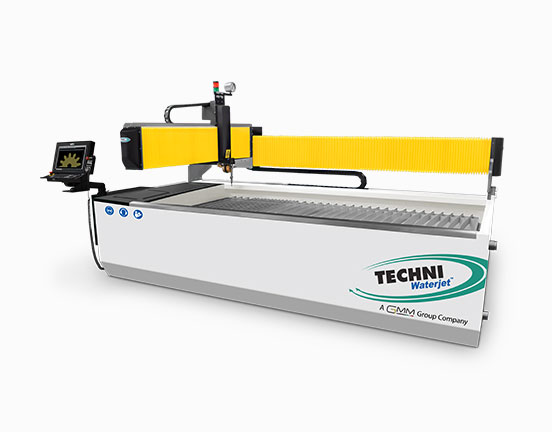
i612-G2
Waterjet Cutting
Machine
| Machine Size | 4900L x 2650W x 2050H mm |
| Cutting Table Size | 1860 x 3690 mm |
| Machine Type | Cantilever |
| Accuracy of Motion (Linear/Axis/Meter) | ±0.15 mm - 0.006" |
| Max Material Thickness | 200mm - 8" |
| Materials that can be Cut | Listed here |
| Price | Enquire for Price |
| Brochure | Download |

i713-G2
Waterjet Cutting
Machine
| Machine Size | 5800L x 3100W x 2100H mm |
| Cutting Table Size | 2000 x 4000 mm |
| Machine Type | Gantry |
| Accuracy of Motion (Linear/Axis/Meter) | ±0.15 mm - 0.006" |
| Max Material Thickness | 200mm - 8" |
| Materials that can be Cut | Listed here |
| Price | Enquire for Price |
| Brochure | Download |

i1020-G2
Waterjet Cutting
Machine
| Machine Size | 8000L x 4200W x 2000H mm |
| Cutting Table Size | 3200 x 6250 mm |
| Machine Type | Gantry |
| Accuracy of Motion (Linear/Axis/Meter) | ±0.15 mm - 0.006" |
| Max Material Thickness | 200mm - 8" |
| Materials that can be Cut | Listed here |
| Price | Enquire for Price |
| Brochure | Download |

i510-G2
Waterjet Cutting
Machine
| Machine Size | 4200L x 2350W x 2050H mm |
| Cutting Table Size | 1550 x 3125 mm |
| Machine Type | Cantilever |
| Accuracy of Motion (Linear/Axis/Meter) | ±0.12 mm - 0.005" |
| Max Material Thickness | 200mm - 8" |
| Materials that can be Cut | Listed here |
| Price | Enquire for Price |
| Brochure | Download |

i613-G2
Waterjet Cutting
Machine
| Machine Size | 5200L x 2700W x 2300H mm |
| Cutting Table Size | 1930 x 3870 mm |
| Machine Type | Monoblock |
| Accuracy of Motion (Linear/Axis/Meter) | ±0.15 mm - 0.006" |
| Max Material Thickness | 130mm - 5" |
| Materials that can be Cut | Listed here |
| Price | Enquire for Price |
| Brochure | Download |

i815-G2
Waterjet Cutting
Machine
| Machine Size | 6580L x 3500W x 2100H mm |
| Cutting Table Size | 2380 x 4780 mm |
| Machine Type | Gantry |
| Accuracy of Motion (Linear/Axis/Meter) | ±0.15 mm - 0.006" |
| Max Material Thickness | 200mm - 8" |
| Materials that can be Cut | Listed here |
| Price | Enquire for Price |
| Brochure | Download |

i1033-G2
Waterjet Cutting
Machine
| Machine Size | 12800 x 5400 x 2200 mm |
| Cutting Table Size | 10150 x 3270 mm 399.6” x 128.7” |
| Machine Type | Gantry |
| Accuracy of Motion (Linear/Axis/Meter) | ± 0.1 mm - 0.004” |
| Max Material Thickness | 200mm - 8" |
| Materials that can be Cut | Listed here |
| Price | Enquire for Price |
| Brochure | Download |
Conclusion
Considering all its advantages and environment friendly nature, waterjet cutting is the best cutting methods out there. This holds true for thin materials, thick materials, soft materials, and hard materials (virtually any material). When cutting materials like rubber, water jet cutting is not only precise, but also very cheap due to the lack of abrasives.
If you make a decision keeping all the important factors in your checklist, waterjet cutting can be a great addon to your workshop. Many manufacturers have already replaced die cutting machines with waterjet cutters.
Therefore, if wondering about whether or not you should use a waterjet cutter in your facility, go ahead with Techni Waterjet without any second thoughts.
